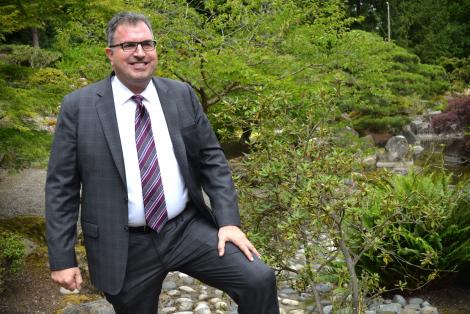By Lindsay Peyton
The Port of Seattle selected the Highline SeaTac Botanical Garden as the site to make a special announcement, launching a $1 million program to fund environmental projects in communities around the Sea-Tac Airport, on the morning of Tuesday, June 20.
The public green space, located at 13735 24th Ave S, was created to preserve gardens in the area that would have been destroyed as part of the demolition in preparation for SeaTac Airport’s third runway.
Instead, the plants were moved to a 10.5-acre site, and the Botanical Gardens were created through an organized effort by the cities of Burien, SeaTac and a number of volunteers. The Port of Seattle also funded the moving and replanting of a number of trees to the area.
“This garden is symbolic of our intent to sustain and improve the quality of life for airport communities,” Port Commissioner John Creighton told the audience gathered to hear the organization’s announcement.
He said that the Port plans to continue efforts to empower cities with similar projects that beautify the surroundings and protect the environment.
“This $1 million fund puts local communities in the driver’s seat,” he said.
The Airport Community Ecology (ACE) Fund offers grants to organizations to improve the natural environment, especially through planting programs.
The Port of Seattle Commission authorized the grant program in November 2016 – and is now ready to set it in motion.
Creighton explained that communities experiencing more impacts from airport operations should also have greater benefits.
“We’re a public enterprise,” he said. “We do operate a business, but we’re also a public agency. So we also look at social equity, job creation and environmental stewardship, most importantly in the communities directly impacted by the airport.”
The Commission directed that the program support environmental projects and programs in the cities of Burien, Des Moines and SeaTac.
Creighton said by making a significant investment in increasing the urban tree canopy, communities will be healthier and benefit by improving water and air quality, providing cooling shade and enhancing the beauty of local neighborhoods.
Groups eligible to apply for grants include community organizations, chambers of commerce, service organizations, youth or athletic associations and non-profits located and providing services in the cities of SeaTac, Burien and Des Moines.
For each dollar requested through the grant fund, $3 of matching funds must be provided by the applicant. This portion could include volunteer labor, donated materials, supplies or professional services.
A seven-member panel, consisting of Port staff and representatives from each of the three cities, will evaluate each application and make recommendations to the Port Commission for final approval.
Applications received by Sept. 1 will be considered for the first round of awards to be made in the fall.
In addition, the SeaTac, Burien and Des Moines can benefit from another part of the Ecology Fund – the Green Cities Partnership Program, Creighton explained.
The Port is partnering with Forterra, a local non-profit organization that promotes regional sustainability by caring for parks and urban forests through its Green City Partnerships program.
“As opposed to reinventing the wheel, we thought we would partner with Forterra, which is already working in the community,” Creighton said.
Forterra will help the cities start initiatives to expand and nurture urban forests, actively involving individuals of all ages in projects like clearing invasive plants, preparing sites for trees and planting saplings and helping them thrive.
“How do we keep the Pacific Northwest a great place to live?” Forterra president
Gene Duvernoy asked. “We make our cities the best they can be.”
He explained that the nonprofit is already actively working with nine cities in the region – and now will start identifying projects and priorities in Buren, SeaTac and Des Moines.
“By creating new Green Cities Programs, we have the chance to enhance the beauty and resilience not only of SeaTac, Burien and Des Moines but the whole region,” Duvernoy said. “It’s not just about planting trees. It’s about neighbor working with neighbor.”
For more information, visit www.portseattle.org/EcologyFund.
For more information about Forterra, visit http://forterra.org.
For more information about the Highline SeaTac Botanical Garden, visit http://highlinegarden.org.
